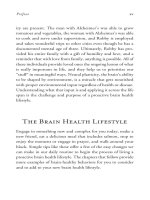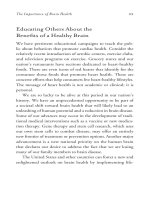Save Your Brain: The 5 Things You Must Do to Keep Your Mind Young and Sharp_4 doc
Bạn đang xem bản rút gọn của tài liệu. Xem và tải ngay bản đầy đủ của tài liệu tại đây (385.49 KB, 15 trang )
The Importance of Brain Health 29
Educating Others About the
Benefi ts of a Healthy Brain
We have persistent educational campaigns to teach the pub-
lic about behaviors that promote cardiac health. Consider the
relatively recent introduction of aerobic centers, exercise clubs,
and television programs on exercise. Grocery stores and our
nation’s restaurants have sections dedicated to heart-healthy
foods. There are even icons of red hearts that identify for the
consumer those foods that promote heart health. These are
concrete efforts that help consumers live heart-healthy lifestyles.
The message of heart health is not academic or clinical; it is
personal.
We are so lucky to be alive at this period in our nation’s
history. We have an unprecedented opportunity to be part of
a societal shift toward brain health that will likely lead to an
unleashing of human potential and a reduction in brain disease.
Some of our advances may occur in the development of tradi-
tional medical interventions such as a vaccine or new medica-
tion therapy. Gene therapy and stem cell research, which uses
our own stem cells to combat disease, may offer an entirely
new frontier of treatment or prevention options. Another major
advancement is a new national priority on the human brain
that declares our desire to address the fact that we are losing
many of our family members to brain disease.
The United States and other countries can foster a new and
enlightened outlook on brain health by implementing life-
Save Your Brain30
long educational programs on the basics of the human brain.
Schools can integrate basic curriculum on the human brain
and brain health promotion at the earliest ages. Libraries can
be reintroduced as community brain health centers, where
basic education and actual implementation of brain health
lifestyle programs can be offered. Preventative programs, both
publicly and privately based, can adopt and help to pay for a
brain health lifestyle for all of us, and brain health centers that
recognize and offer research-based activities for the consumer
can emerge. Our grocery stores and restaurants can begin the
process of identifying for the consumer foods that have brain-
health-promoting effects. New businesses and retail outlets that
cater to the vitality of the human brain and our cognitive and
emotional abilities will continue to emerge.
A nation that prioritizes brain health understands that a life-
long and proactive lifestyle is needed. Individuals must educate
themselves about their own brain and begin to make the behav-
ioral changes necessary to develop as healthy a brain as possible.
Businesses, schools, churches, the media, and health care sys-
tems can begin to promote brain health in their own specialized
ways, and our daily language will refl ect a society that embraces
the importance of caring for our brains. Ultimately, however,
the desire for education on the basics of the human brain and
desire to change behavior toward a proactive and lifelong brain
health lifestyle begins with the individual.
31
2
How Your
Brain Works
There will never be anything developed by mankind that approximates
the power and effi ciency of the human brain.
7
W
e know that the human brain is a wonderfully complex
system that permits our every thought, emotion, and
movement. It is very important for you to learn about the basics
of your brain and how your brain actually works to grasp the
importance of the brain health lifestyle. This chapter is dedi-
cated to helping you understand how your own brain works
and how you really have an important role in being able to
shape your own brain for health.
Parts of the Brain
The study of the human brain can be a very intimidating under-
taking, and this might actually keep some from even trying to
Save Your Brain32
learn. I want you to realize that your brain is really about who
you are. If you can personalize this brilliant system that sits
within your skull, you can begin the process of learning about
you. There are actually some easy methods to learn about the
structures and functions of your brain: I teach the basics of
the brain using some simple techniques that organize the brain
into different sections. This typically makes the learning quite
simple and interesting. Give it a try and learn something new
about yourself.
The fi rst learning technique is to think of the brain divided
into a “top-down” orientation, with cortex at the top and the
subcortex at the bottom. While these two regions of the brain
are distinct, each with specifi c responsibilities, they are also
integrated, helping the brain to operate like a symphony.
Cortex
Your brain weighs two to four pounds and is made up of gray
matter and white matter. The gray matter tends to be contained
in an area of your brain called the
cortex, a word that translates
to “bark of a tree.” Your cortex (see Figure 2.1) is a convoluted
mass of cells with folds and fl aps that sits snug within your
skull. The white matter is situated more deeply in the brain,
beneath the cortex, and helps to bridge or connect different
regions of the brain. White matter helps to propel information
and to insulate cells and nerve tracts.
It developed from the back to the front, meaning the front
part of your cortex is the most recent member or region of your
How Your Brain Works 33
brain to develop, evolutionally speaking. The cortex is primar-
ily responsible for your most complex thinking abilities, includ-
ing memory, language, planning, concept formation, problem
solving, spatial representation, auditory and visual processing,
mood, and personality. Processing in the cortex tends to be
conscious and intentional. For example, the cortex is respon-
sible for your reading this book at this very moment—your
intent to educate yourself about brain health is driven by your
cortex.
The cortex is generally organized by four primary regions, or
lobes: the frontal, temporal, parietal, and occipital (see Figure
2.2). Each of these four lobes has specifi c behaviors and func-
tions primary to its region. For example, the frontal lobes are
Figure 2.1 The Cerebral Cortex
Save Your Brain34
also known as the
executive system since they help execute behav-
ior, organize behavior, plan, conceptualize, maintain cognitive
fl exibility, and stabilize mood. Your personality is thought to
reside in the frontal region of your brain. Your temporal lobes
are the site of your auditory brain, memory and new learn-
ing, language, and perhaps religiosity. Your parietal lobes help
you with orientation to space, memory, reading and writing,
mathematics, and appreciation of left versus right. Finally, your
occipital lobes help you to see, discriminate what you see, and
perceive.
Figure 2.2 The Four Lobes of the Brain
How Your Brain Works 35
Subcortex
Sitting just under the cortex and on top of the ascending brain
stem are a number of smaller and generally more primitive
structures (relative to the cortex) known as the
subcortex. Your
subcortex primarily processes rote skills and procedures. Some,
if not most, of the processing conducted in the subcortex is
subconscious. Activities such as driving, dressing, typing, and
most other routine tasks involve multiple rote procedures that
are conducted at a subconscious level. Your subcortex and cor-
tex are distinct regions of the brain, but they do not sit in isola-
tion of one another. In fact, there are numerous connections
between these two important brain regions. The brain operates
as a symphony, with numerous and distinct regions harmoniz-
ing perfectly as one unit.
Left and Right Hemispheres
The second learning technique divides the brain “left to right,”
appreciating that the brain is comprised of two distinct yet
integrated hemispheres we call the
dominant and non- dominant
sides of the brain. We refer to these sides as
hemispheres, and
you have a left hemisphere and a right hemisphere (see Figure
2.3). Each hemisphere is connected by a bridge known as the
corpus callosum. As you will learn in this section, each hemi-
sphere has some distinct, yet not necessarily mutually exclusive,
responsibilities.
Interestingly, your behaviors and functions are related pri-
marily to one of these two hemispheres. For example, most of
Save Your Brain36
us—and nearly all right-handers—have language distributed
primarily in the left hemisphere. We refer to the hemisphere
in which language is based as the dominant hemisphere as a
sign of our respect for the importance of language. Left-handers
with a parent who is left-handed, a relatively rare phenomenon,
have a higher probability than right-handers of having language
functioning distributed primarily in the right hemisphere. They
would be right-hemisphere dominant.
Figure 2.3 The Hemispheres of the Brain
How Your Brain Works 37
Your dominant hemisphere—left for most of us—also pro-
cesses details, is task-oriented, logical, analytical, and sequences
information. Most of Western civilization is built around the
left hemisphere, as our classrooms are set up in rows and col-
umns of chairs, and our cities tend to have tall buildings in
rows and columns. We tend to focus more on the detail and
less on the gestalt. Your non-dominant hemisphere helps you
process non-language information, such as size, shapes, sounds,
and space. Your ability to navigate in space, locate your car in a
parking garage, or get home from a walk is an example of non-
dominant function. Likewise, your ability to appreciate distinct
sounds, such as a baby’s cry or a fi re alarm, tends to be a process
of the non-dominant hemisphere.
Your two hemispheres are connected by a bridge of cells
referred to as the
corpus callosum. Information crosses from one
side of your brain to the other over the corpus callosum, and
this is a critical part of your brain’s ability to remain so func-
tional despite its many complex operations on a daily basis.
Interestingly, the female brain is thought to have a larger corpus
callosum, which underscores the notion that female brains pro-
cess information differently from male brains. Females tend to
utilize both sides of their brains more to process than men, who
tend to rely primarily on one side, the dominant hemisphere.
It is probably not coincidental that audiences across the nation
always respond with the same answer to my question, “In what
area of a common behavior do men and women struggle with
each other on a daily basis?” The answer is communication,
which you’ll learn more about in the chapters ahead.
Save Your Brain38
Neurons
The operation and function of your brain is ultimately con-
ducted by the millions of brain cells we refer to as
neurons.
A neuron (see Figure 2.4) contains a cell body sometimes
referred to as a
soma, a long arm extending out from the cell
body referred to as an
axon, and branchlike fi gures called den-
drites
that extend out into the brain environment seeking new
information to relay back to the cell body.
Indeed, information from the cell body travels down the
axon into the surrounding brain, while information from the
environment is gathered by the dendrites and brought back to
the cell body. This ongoing exchange of information by the
brain is why we refer to it as the
central information processing
system
.
We are taught that our brains contain millions of brain cells
and that each neuron can communicate with another ten thou-
sand neurons. Interestingly, one neuron never touches another
neuron, but two cells may communicate via chemicals, and this
chemical marriage is called a
synapse. The more synaptic connec-
tions you develop over your life span, the healthier your brain
may be, because it is building up
brain reserve. Brain reserve, as
you will learn, may have the ability to delay the onset of neuro-
degenerative diseases such as Alzheimer’s.
The miracle is that your brain is dynamic and continues to
be shaped and to develop. It has
plasticity. As such, there is no
fi nite capacity or limitation. In this way, your brain is very dis-
tinct and actually much superior to the fanciest of all comput-
ers because computers will always have built-in limitations and
How Your Brain Works 39
fi nite capacity. Your dynamic brain is shaped by environmental
input across your life span, beginning in the womb. There really
is no critical period of brain development, unless one considers
life itself to be the measure. As you will learn in the next section,
the type of environmental input your brain receives can make a
Figure 2.4 A Neuron
Save Your Brain40
difference regarding the health of your brain. You do have some
control, and this is great news!
Hippocampus
When I give lectures to the public, I always want my audience
to personalize the message. This story is, after all, about you and
your brain. It really does not get any more personal. Learning
about oneself can be fun and challenging. There is one part
of your brain that I emphasize because this structure, the
hip-
pocampus
, is so critical to you and your life story. A hippocam-
pus (see Figure 2.5) sits in the middle of each of your temporal
lobes, which lie under your temples on each side of your head.
Your hippocampus, or hippocampi, for plural, as you have
one in each hemisphere, takes new information in and main-
tains the information in a type of working buffer. If you believe
the information is important and you need to store the infor-
mation for an extended period of time, your hippocampus will
transition the information to a specifi c area of your cortex. This
process is not random, but rather very sophisticated, as the pro-
cess of storage seems to be stimulus-based. That is, if you are
learning information that is visual, your hippocampus will help
store that information permanently in the visual cortex of the
brain. The same process is thought to occur for the other four
types of sensory input: sound, touch, taste, and smell.
Your hippocampi represent your vital learning and encod-
ing structures, thereby helping you to build your life story and
maintain your personal memories. Alzheimer’s disease, as men-
How Your Brain Works 41
tioned in the previous chapter, is a leading cause of dementia,
and the disease destroys very early the hippocampi of the brain.
As a result, those affl icted with this terrible brain disease can-
not learn new information, and they typically will repeat state-
ments. As you will learn in the next section, your hippocampi
are critical structures to brain health. Recent research suggests
your hippocampi have tremendous ability, including new brain
cell development referred to as
neurogenesis.
Figure 2.5 The Hippocampus
Save Your Brain42
Environmental Effects on
Brain Plasticity and Reserve
We now believe that the human brain is shaped by our environ-
ment. This means that our brain will respond to everything that
we do and all that is going on around us. Something as simple
as a television show or a hug, or as complicated as screaming
at someone or experiencing loss and grief affects the structure
and function of our brain. This wonderfully intricate marriage
between environment and brain function defi nes neural plastic-
ity and enables us to consider what environmental input might
be best to promote our own brain health. Your understanding
of this simple fact and the power of neural plasticity permits
you to engage in a proactive effort to shape your own brain
across your life span.
Every day we have experiences that can teach us about the
function of our brain and how environment and our brain have
an important and ongoing relationship. I often say that the
chemistry of our brains is altered all the time, but not with pills,
syringes, or liquids. Instead, words may be the single great-
est neurochemical activator, and messages provided to us by
our parents have a particularly long-term effect. Other envi-
ronmental stimuli, such as temperature, touch from another,
pain, imagery on television or the movies, emotional events,
news, victory and defeat, loss, and many others affect our mood
and disposition, a result of neurochemical change. Such change
then typically leads to behavioral change, and this is how we
How Your Brain Works 43
lead our lives. In short, environment shapes our neurophysiol-
ogy and behavior every day.
It is important you learn about the power of your brain and
how it can be shaped and nurtured over the course of your life.
We refer to the dynamic, constantly reorganizing, and mal-
leable nature of your brain as
brain plasticity. Understand that
your brain is not a rigid or static system with a limited capacity
or fi nite critical period for development. The power of brain
plasticity permits you to implement a lifelong and proactive
program to grow and promote your own brain health.
Animal Brain Research: How the
Environment Affects the Brain
To better understand why brain plasticity is important to you,
we can look to some basic fi ndings of animal brain research.
In the 1950s, research was conducted to investigate whether
environment had any effect on the structure and function of the
animal brain. Researchers designed a study with rodents raised
in two distinct environments: an “enriched” environment ver-
sus an “unenriched” environment. Rodents were raised in one
of these two environments, and then their brains were analyzed
and compared at autopsy. Results yielded signifi cant differences
in the brains of these rodents. Specifi cally, rodents raised in an
enriched environment had a larger cortex, more cellular con-
nections, called
synapses, that lead to brain reserve, and devel-
oped new brain cells, called
neurogenesis, in the hippocampus,
the structure critical to new learning and memory.









